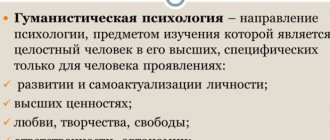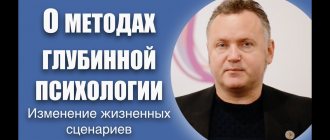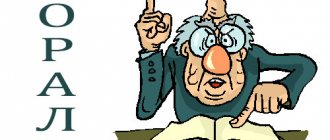Psychology is a multifaceted and versatile science. It has many directions and branches, each of which is focused on its own understanding of mental reality and the characteristics of its functioning. Each direction has its own approach to analyzing aspects of the psyche. Cognitive psychology is one of the relatively young, but quite progressive and very popular areas. This article is devoted to a brief overview of this area, as well as an overview of the related therapeutic approach - cognitive psychotherapy.
Concept of cognitive psychology
The word itself comes from the Latin language - cognitive. It means “knowledge”, “to know”. A branch of psychology deals with the study of cognitive processes in the individual’s psyche.
List of processes:
- memory;
- logical thinking;
- attention;
- emotions;
- speech;
- imagination.
Cognitive psychology is a branch of experimental psychology that studies cognitive processes in the human brain.
This also includes the ability to make decisions. The concept includes all cognitive processes for the use and structuring of information by the brain.
Cognitive psychology is needed in the study of artificial intelligence, since the work of the brain can be described by an algorithm:
- information comes in;
- the brain processes it;
- the brain receives new knowledge, it is stored in memory.
This is necessary when modeling mathematical thinking. In science, it is also applicable to artificial intelligence, by analogy with the work of the human brain.
Cognitive psychology, to put it briefly and clearly, studies a person, comparing him with a system , based on the receipt of information from the outside world, its processing, and storage in memory. Even the term “information processing” has migrated from engineering fields to the field of cognitive psychology.
Cognitive psychology was considered an alternative to outdated behaviorism.
The direction was based on experiments conducted on animals. It was believed that the human psyche also works 100%. In the 60s there was a “cognitive revolution” that opened up a new field. She views the human psyche as an area that needs to be explored, but moving away from any connection with animal experiments.
Where to get training
To become a cognitive psychologist, you need to receive specialized education. To do this, you need to enter a university at the faculty of “general psychology” or “clinical psychology.” After 4 years of study, the specialist receives a bachelor's degree. It is best to continue studying and become a master of psychology. A master's degree provides great opportunities for career growth.
Psychological education is available in such universities as:
- Leningrad State University named after A. S. Pushkin;
- St. Petersburg State Institute of Psychology and Social Work;
- Russian State Humanitarian University;
- Kursk State Medical University;
- Kuban State University;
- Siberian Federal University;
- South Russian Humanitarian Institute.
Unfortunately, in universities they do not teach to be a cognitive psychologist. Cognitive behavioral therapy can be learned through professional retraining courses. Their duration at the Academy of Professional Standards is 3 months. During this time, the specialist receives basic knowledge in the field of cognitive and cognitive-behavioral psychotherapy and acquires practical skills. On the basis of the same educational institution, he can take advanced training courses, which teach the latest psychotherapeutic techniques.
All psychologists, as well as doctors with higher medical education, have the opportunity to complete professional retraining courses in cognitive psychology.
What does cognitive psychology study?
Cognitive psychology examines the cognitive processes of the psyche, which are involved in searching, processing and storing information. The processes are discussed in detail below.
Memory
Cognitive psychology (briefly and clearly about the methods of this type of psychology is written later in the article) pays a lot of attention to human memory. Memory is responsible for storing information already processed by other cognitive processes. It reproduces a person’s past experience in a given situation.
Memory is one of the main processes in the human psyche
Memory is one of the main processes in the human psyche. It is applied in real human life. Memory allows him to use memories, acquired knowledge, helps to store information about his reaction to certain events, emotions that a person experienced (excitement, fear, joy, anger).
Thinking
Thinking allows an individual to make decisions by connecting images, memories, concepts, accumulated experience (stored information). Thinking makes it possible to understand, accept or change the received images and concepts.
You can briefly and clearly explain how thinking works by describing the situation in a coffee shop. The man decided to order coffee. In front of it is a list of available drinks (external information appears). The human brain processes information using memories.
For example, memory says that he didn’t like the cappuccino last time. The individual concludes that the drink is not suitable. He chooses another drink, which, thanks to his imagination, causes a surge of pleasant emotions. Therefore, thinking occupies a large area of study in cognitive psychology.
Types of thinking
Cognitivism implies the division of thinking into 2 groups: conscious and unconscious.
In science there are 3 types of thinking:
- Visually effective. It involves the production and organization of activities. The coffee situation would fall into this type.
- Visual-figurative. The type translates thoughts into images.
- Abstract ─ abstract reasoning.
Attention
Process means the direction of a person’s perception towards an object or situation. Attention means a particularly heightened interest of an individual in order to obtain information.
| Selectivity | A property in which the human brain clings precisely to the necessary information, cutting off the unnecessary, in order to achieve the goal. |
| Sustainability | The ability of the brain to fixate on a specific task for a long time in order to obtain the necessary data. |
| Concentration | Generalized concept of selectivity. It helps you focus on an object. |
Emotions
Emotion is understood as a mental process that arises as a reaction to situations. An interesting fact is that the emotion can appear even before the situation begins. For example, excitement before an important event.
Decision making ability
The ability to make decisions is directly related to another cognitive process - thinking. Decision making is necessary in order to achieve a goal. A goal is a task in which there are difficulties and obstacles. The essence of making a decision will be to overcome these same obstacles.
The ability to make decisions is necessary to achieve a goal.
Decision making is achieved through an approximate algorithm:
- First, the brain recognizes the task.
- Next, you evaluate your capabilities - whether there are enough resources to overcome obstacles to solving the problem.
- With the help of thinking, an action strategy is developed that will solve the problem, concentration appears, and the brain processes memory (experience, knowledge).
- Connecting the physical and intellectual capabilities of the individual (they are assessed in point 2).
- Control over progress. The brain analyzes whether it is possible to continue according to the same scheme, or whether it is worth abandoning it by developing a new chain (lack of resources, change in the initial goal).
Example of a decision making algorithm
- Evaluation of the result. The end result can evoke emotions, both positive and negative. If expectations are justified and the goal is achieved, positive ones arise. Emotions are remembered, information is processed and stored in memory. In the future, an individual in a similar situation will remember whether the chosen algorithm worked or whether a different course of action needs to be chosen.
Characteristics of the essence of behaviorism as a science that studies behavior in an objective way
Behaviorism is a trend in twentieth-century psychology that considers the subject of psychology to be behavior, which is understood as a set of physiological reactions of an individual to external stimuli. At the beginning of the 20th century, behaviorism (from the English word behavior) or behavioral psychology became an influential trend in psychology, which is credited with “revolutionary” significance. Its experimental premise was the study of animal behavior conducted by E. Thorndike (1874-1949). Many of his findings were taken into account in explaining human behavior. He believed that pedagogy should be based on the psychology of behavior. E. Thorndike is the founder of behavioral psychology and objective psychology. He views the human psyche and behavior as a system of reactions of the body to internal and external stimuli.
In 1913, John Watson (1878-1958) formulated the basic principles of behavioral psychology. The main principle is not to study oneself, but to study the behavior of a neighbor. In this way, a person explains his own behavior. Watson believed that the study of oneself is a subjective assessment, and behaviorism examines psychological phenomena objectively. Therefore, one should study the behavior of other people and their reactions to environmental influences, i.e. incentives. This is the essence and meaning of behaviorism. Many of its provisions explain the influence of external factors on people’s behavior, activities and interpersonal communication.
Behaviorists studied behavior and activity. Activity - external and internal - was described through the concept of “reaction”, which included those changes in the body that could be recorded by objective methods - this includes movements and, for example, secretory activity.
As a descriptive and explanatory one, D. Watson proposed the SR scheme, according to which the impact, i.e. stimulus (S) gives rise to some behavior of the organism, i.e. reaction (r), and, importantly, in the ideas of classical behaviorism, the nature of the reaction is determined only by the stimulus. Watson's scientific program was also connected with this idea - to learn to control behavior. In fact, if the response is determined by the stimulus, then it is enough to select the right stimuli to obtain the desired behavior. Consequently, it is necessary to conduct experiments aimed at identifying the patterns by which stimulus-reactive connections are formed, to organize careful monitoring of situations, and recording behavioral manifestations in response to the influence of a stimulus.
The principles of classical behaviorism look simplified. Subsequent experimental practice did not confirm the validity of the original scheme as universal: in response to the same stimulus, different reactions may follow, and the same reaction can be stimulated by different stimuli. The stimulus dependence of the response was not questioned; however, the question arose that there is something that determines the reaction, in addition to the stimulus, or more precisely, in interaction with it. Researchers who developed Watson's ideas proposed introducing one more instance into the argument. Usually denoted by the concept of “intermediate variables,” meaning some events in the body that are affected by the stimulus and which, not being a reaction in the strict sense (since they cannot be objectively recorded), also determine the response. (SOR Scheme).
One of the most authoritative behaviorists is B. Skinner, who suggested that behavior can be built on a different principle, namely, determined not by the stimulus preceding the reaction, but by the likely consequences of behavior. This does not mean freedom of behavior (although within the framework of his approach the problem of human “self-programming” is discussed); In general, it is meant that, having had a certain experience, an animal or person will tend to reproduce it if it had pleasant consequences, and avoid it if the consequences were unpleasant. In other words, it is not the subject who chooses the behavior, but the likely consequences of the behavior that control the subject.
Accordingly, behavior can be manipulated by rewarding (i.e., positively reinforcing) certain behaviors and thereby making them more likely to occur; This is the basis for the idea of programmed learning proposed by Skinner, which provides for “step-by-step” mastery of an activity with reinforcement for each step.
A special direction within the framework of behaviorism is sociobehaviorism, which was most actively formed in the 60s. New to what we have been talking about is the idea that a person can master behavior not through his own trial and error, but by observing the experiences of others and the reinforcements that accompany this or that behavior (“observational learning” , “learning without trial" This important difference assumes that human behavior becomes cognitive, i.e. Includes an indispensable cognitive component, in particular, symbolic. This mechanism turns out to be the most important in the process of socialization; on its basis, methods for implementing aggressive and cooperative behavior are formed. This can be illustrated by the experiment of the leading psychologist of this direction, Canadian Albert Bandura.
Representatives of neobehaviorism Edward Chase Tolman (1886-1959) and Clark Leonard Hall (1884-1952) tried to explain human mental activity from the standpoint of behaviorism methodology. They came up with the concept of “mediators” - internal processes occurring between stimulus and response. At the same time, they proceeded from the fact that for “invisible mediators” there should be the same objective indicators that are used when studying stimuli and reactions accessible to external observation. However, their concept turned out to be unconvincing in a scientific sense and has largely lost its influence. There was a return to classical behaviorism, especially expressed in the work of Burres Frederick Skinner (b. 1904).
What is the cognitive approach
The cognitive approach is based on the fact that the human brain is capable of not only mechanically responding to external influences, but can also analyze incoming data and compare various facts.
On this basis he can:
- decisions;
- solve problems;
- set goals and objectives.
The cognitive approach is based on the fact that incoming information from the outside world goes through “processing” inside the psyche. Therefore, different data are perceived differently by individuals.
Cognitive psychology examines the limited capacity of a system. That is, a person’s “memory capacity” is limited. Reception of new information, storage of old information - this resource is limited. Therefore, the cognitive approach is based on modeling new ways of working with such a process of cognitive activity as memory.
With the help of the cognitive approach in psychology, a stable concept is formed that the physical world around us is perceived by the psyche in a special form “transformed” by the individual. And it cannot be reduced to the properties of stimulation.
Cognitive psychology (a brief and clear definition of CBT is given at the end of the article) is regularly used to train school-age children, as well as for adults in psychotherapy.
Cognitive behavioral psychotherapy
cognitive approach in psychology
Today, with the help of cognitive behavioral psychotherapy, therapists work with people’s mental disorders: eliminate them, smooth them out, or reduce the likelihood of future relapses. It helps eliminate psychosocial consequences, correct behavior, and increase the effectiveness of medication treatment. This direction was based on the ideas of George Kelly.
Kelly's personality construct theory states that each mental process proceeds through different ways of predicting events in the surrounding reality. Human consciousness and behavior are not controlled by instincts, incentives, or even the need for self-actualization. He acts as a scientist, studying and understanding the world around him and himself.
According to Kelly, a person, by studying the behavior of others, trying to understand its essence and make predictions, builds his own system of personal constructs. The concept of “construct” is fundamental in the scientist’s theory. The construct consists of the characteristics of perception, memory, thinking and speech and is a classifier of how a person perceives himself and the world around him.
This is the main means for classifying the phenomena of reality, which is a bipolar scale, for example, “stupid-smart”, “beautiful-ugly”, “brave-cowardly”, etc. The process of a person’s choice of constructs characterizes him as an object of cognition, which is the subject of interest of all therapy. The constructs form a system, and if it turns out to be ineffective, a healthy person either changes it or replaces it with a new one. In case of mental disorders, they resort to therapy.
In general terms, therapy can be defined as a comparative analysis of the characteristics of people’s perception and interpretation of external information. This analysis consists of three stages:
- At the first stage, the patient works with various tools that help identify erroneous judgments and then find their causes.
- At the second stage, the patient, with the help of a therapist, masters techniques for correct correlations between phenomena in the surrounding world. The specialist’s task is to show a person the benefits and harms, advantages and disadvantages of an existing construct.
- At the third stage, the patient must become aware of the new construct and begin to build his behavior on its basis.
It is important to note that the specialist only starts the treatment process, and then simply corrects it. And a lot here (which is also typical in other areas of psychiatry and psychology) depends on the person undergoing treatment.
Kelly's theory describes a conceptual framework that allows a person to make sense of reality and create specific behavioral patterns. By the way, it was supported by the famous Canadian and American psychologist Albert Bandura. He developed a system of "observational learning" used to change behavior.
The personal construct itself is used by world experts who study the causes of low self-esteem, fears and phobias, and depressive states. Cognitive psychotherapists believe that the cause of any mental disorder lies in dysfunctional (wrong) constructs. This is why Kelly's theory is so important for therapy.
Methods of cognitive psychology
There are several methods of cognitive psychology. The main one is the method of microstructure analysis.
During its implementation there are 3 stages:
- Logical analysis. Using the tools of cognitivism, the specialist allows the patient to see his erroneous judgments.
- Empirical analysis. At this stage, techniques are being developed that will help a person to correctly correlate objects of reality with each other.
- Pragmatic analysis. The last stage is that the patient learns to be optimally aware of his actions.
This method is used in the treatment of depression. The microstructure analysis method is also used for people who underestimate themselves.
Cognitive scientists believe that personality problems begin due to incorrect patterns of action. Therefore, the main goal of the method is to teach an adequate, adaptive method of behavior to an individual, which will solve problems after consolidating a new skill.
It turns out that cognitive scientists study not the personality as a whole, but the mechanism of its social attitudes, which have already been formed and stored in memory. A specialist can see how the generated algorithms interfere with or help an individual perceive the world around him and its impact.
Self-knowledge includes three components: thoughts, feelings, actions.
The second method is knowing yourself.
The method of self-knowledge also has several stages:
- Early childhood period. It is from childhood that the process of self-knowledge begins. A child is born into a family, he has his own “important adults.” Gradually, by about 3 years of age, separation from these adults begins and personality formation occurs.
- The next stage is a crisis. The child is looking for himself, his inner “I” is being formed.
- Adolescence. This stage is called active self-knowledge. The teenager is already quite independent, he is able to separate himself from his “important adults”. The process of separation from parents is approaching.
During this important period, a lot of information comes in, the teenager highlights his values, his ideals, and his worldview is formed. In the process of such active self-knowledge, a large number of internal conflicts and contradictions occur. And because of them, external conflicts with the outside world appear.
Self-analysis allows you to identify your strengths and weaknesses
Analyzing yourself is the first place to start. On the path to self-improvement, you need to observe your actions, what caused them, what memories, what emotions they evoke.
Analysis of your actions occurs with the help of memory and thinking. You can compare recent situations with similar ones that happened a month or a year ago. It is necessary to grasp what reaction this or that situation causes. And what actions contributed to this outcome.
Self-observation will help you evaluate your capabilities, your resources, which will be necessary when solving problems.
Research methods
It must be admitted that the goal that cognitive psychology sets for itself is important, but it is also very difficult to measure. How can you explore something that you can't touch? How to study processes that are undoubtedly produced by the brain, but it is still not clear how exactly this happens?
Through laboratory experiments.
We will not delve into the issues of the scientific method of cognition, because more than one article could be devoted to this. However, to summarize, the study goes through the following stages:
- Scientists want to study the quality of memorization of material depending on the presence of sound interference.
- Then they think about how this can be measured and formulate a more specific hypothesis: the amount of material reproduced is inversely proportional to the volume of external sound interference at the moment of memorization. That is, the louder the noise during memorization, the less material a person remembers.
- Next comes the preparation of the experiment: the choice of material for memorization, the choice of sounds, the volume of which will increase.
- Selection of subjects. The more participants in the study, the more accurate the data.
- Conducting an experiment.
- Mathematical processing of results. Let’s imagine that 150 people took part in the experiment, scientists enter all the results into a database, look for patterns, check whether their hypothesis is confirmed
- Conclusions, presentation of results. If the hypothesis is confirmed, certain conclusions can be drawn from this, some of which will be applicable in practice. For example, in the case of memorization, we can conclude that people learn better in quiet rooms. If the hypothesis is not confirmed, you can assume the reasons and put forward a new hypothesis. Speaking about our supposed experiment, the hypothesis would not be confirmed. Because in absolute silence it is also quite difficult to remember new information. Have you ever been in a completely soundproofed room? When silence literally weighs on your ears, you can't learn much.
- And here we move on to the next point. Based on the findings, scientists can put forward a new hypothesis. For example, that there is a certain noise level that is most comfortable for remembering.
- Scientific research enters the second round, everything is repeated from the beginning, but with a new hypothesis.
This is how, with small steps and small experiments, scientists are achieving more and more new knowledge that can be useful in our lives. But what is the practical benefit here? Let's talk about this further.
Definition of Cognitive Dissonance
Cognitive psychology (its definition is briefly and clearly given in the article) includes cognitive dissonance - a state of the human psyche when a large internal conflict arises .
Example of cognitive dissonance
The concept itself was introduced by the American social psychologist Leon Festinger. Translated from Latin, we get 2 words - “cognition” and “imbalance”. Therefore, this mental state is otherwise called an imbalance of cognitive functions, which were described above (attention, memory, speech, thinking).
Basic provisions
During its existence, many important points appeared in the direction. The first postulate is the inseparability of behavior and consciousness. The second core concept of cognitive psychology is dissonance. It arises at a moment when a person wants to achieve inner harmony, but then he is visited by new experience and knowledge. All this comes into conflict and dissonance arises.
In total, the researchers were able to identify several principles:
- Intelligence is a complex system;
- Psyche is a system of cognitive reactions;
- The unconscious is also involved in the process of information processing.
During the development of the direction, many new definitions appeared. For example, cognition began to be understood as the process of transformation of received information.
Today, cognitive psychology continues its development. Its main goal is to collect important data about the peculiarities of the process of obtaining and processing information.
Causes of dissonance
Leon Festinger came up with 2 hypotheses that can explain the reasons for the imbalance:
- When faced with an internal contradiction, a person tries to overcome it, because a feeling of strong tension arises.
- In the future, the individual diligently avoids similar situations, since the memory is deposited in the memory, the emotions that this contradiction caused are remembered.
Causes of cognitive dissonance
The imbalance arises due to the fact that the brain is accustomed to ordering all systems of life and human perception. This is how cognitive processes work. But everything can change when unexpected new information, ideas, goals are received.
When something new comes in, the brain has no algorithm for action. At this moment, an internal conflict and mixed feelings arise. A coherent cognitive system does not work 100%.
Cognitive psychotherapy techniques
The cognitive approach to therapy is inextricably linked with the formation of cognitive psychology, which places the main emphasis on the cognitive structures of the psyche and deals with personal elements and logical abilities. Cognitive psychotherapy training is widespread today. According to A. Bondarenko, the cognitive direction combines three approaches: direct cognitive psychotherapy by A. Beck, the rational-emotive concept of A. Ellis, and the realistic concept of V. Glasser.
The cognitive approach involves structured learning, experimentation, mental and behavioral training. It is designed to assist the individual in mastering the operations described below:
— detection of one’s own negative automatic thoughts;
— finding connections between behavior, knowledge and affects;
— finding facts “for” and “against” identified automatic thoughts;
— finding more realistic interpretations for them;
— training in identifying and transforming disorganizing beliefs that lead to deformation of skills and experience.
Training in cognitive psychotherapy, its basic methods and techniques helps to identify, dismantle and, if necessary, transform negative perceptions of situations or circumstances. People often begin to fear what they have prophesied for themselves, as a result of which they expect the worst. In other words, the individual’s subconscious warns him of possible danger before he gets into a dangerous situation. As a result, the subject becomes afraid in advance and tries to avoid it.
By systematically monitoring your own emotions and trying to transform negative thinking, you can reduce premature fear, which can be modified into a panic attack. With the help of cognitive techniques, it is possible to change the fatal perception of panic attacks that is characteristic of such thoughts. Thanks to this, the duration of a panic attack is shortened and its negative impact on the emotional state is reduced.
The technique of cognitive psychotherapy consists of identifying the attitudes of patients (that is, their negative attitudes should become obvious to patients) and helping them to understand the destructive impact of such attitudes
It is also important that the subject, based on his own experience, make sure that, due to his own beliefs, he is not happy enough and that he could be happier if he were guided by more realistic attitudes. The role of the psychotherapist is to provide the patient with alternative attitudes or rules
Cognitive psychotherapy exercises for relaxation, stopping the flow of thoughts, and controlling impulses are used in conjunction with the analysis and regulation of daily activities in order to increase the subjects’ skills and focus on positive memories.
Cognitive behavioral therapy: applied work with thoughts and behavior
Cognitive behavioral therapy is considered one of the most used methods of work in psychology. It helps to highlight a person’s unconscious motivation for certain actions. Then the method will help to transform them into conscious ones and lead to changes in established beliefs and behaviors, which will subsequently lead to the elimination of neurotic conditions.
Cognitive behavioral therapy helps to highlight a person’s unconscious motivation for certain actions, change established beliefs, thereby eliminating neurotic conditions
This method of therapy includes methods from 2 areas of psychology:
- Cognitive. He says that mental disorders can arise on the basis of skills, memories, and judgments acquired throughout life.
- Behaviorist. This direction suggests that the desired behavior can be obtained if it is rewarded, as it works in animals.
Representatives
Psychology of communication - how to learn to talk to people correctly
The direction received its name thanks to D. Bruner. He actively wrote scientific works about cognitivism in psychology, conducted experiments and even created a special center. During his life, he studied memory, thinking, speech a lot, all this allowed him to make a significant contribution.
The most famous in this area was Jean Piaget. He was actively involved in experiments with children. In the course of them, he was able to identify many patterns in the development of thinking.
For example, Piaget believed that the first stage of intelligence development lasts up to two years.
Cognitive psychologist, W. Neisser, in his book talked about the features of cognition. J. Kelly supplemented his work with the theory of personal constructs. According to it, cognitive activity is maximally aimed at predicting the future.
How does a consultation with a cognitive behavioral psychologist work?
The consultation is divided into several stages. The first of these is determining the client's condition. The psychologist, through leading questions, learns about how the week, day went, and how the client feels.
A conversation with a psychologist should take place in a calm and friendly atmosphere
Next, based on the client’s condition, a further plan is determined, according to which you can understand what today’s conversation will be about. It will be focused on what is priority now for the client, what worries the most. A prerequisite will be for clients to complete their homework.
He will need to analyze his behavior, his reactions to various life situations. He conducts various experiments under the guidance of a psychologist, tries new models of behavior. Keeping a diary is also a common practice. This could be a diary of emotions (negative and positive) or achievements.
Types of cognitive processes
Low or basic
Sensation and perception
A sensation is something that is formed under the action of various stimuli, as well as the determination of signals from a person’s environment. He accepts them with the help of his feelings. This is how information is acquired from the environment around you. Data comes from the outside world, and sometimes from the human body. The process of perceiving a basic type includes some interpretation of the information received.
Attention! There is plenty of information around, yet each person has the ability, having received many different signal stimuli, to pay attention to what is really interesting to her. Some actions do not require attention
This is, for example, moving or chewing food. Others require attention without fail, such as speech or body language.
Some processes that are repeated often in life are done automatically. When learning to drive a car, it is difficult to immediately act in a coordinated manner, but then less and less effort is put in, as automaticity develops.
About memory
Human memory stores answers to a fairly large number of different questions. It encrypts data, it is able to save it, and then restore it if necessary. The classification of types of memory is as follows:
- Memory is short or short-term;
- Sensory type memory;
- Semantic type memory;
- Working memory;
- Autobiographical memory and others.
All of these species are capable of interacting or not. For example, if a person with amnesia remembers where he needs to go today, he may forget the name of his closest relative.
Attention and memory
Processes are complex and higher
Intelligence or mind
This concept means an ability that gives an individual the ability to solve a variety of problems. Some scientists have popularized in society the theory that there is no intelligence, but only different abilities that are used according to the situation or activity.
On a note
In order to skillfully deal with different circumstances in everyday life, many researchers emphasize the importance of emotional intelligence
Thinking
Human thoughts are complex and heterogeneous. This process is necessary in order to make decisions, reason, solve problems, and think creatively.
In order to make these functions somewhat simpler, the human brain creates judgments and inferences. In order for mental processes to speed up, it is necessary to group events, people, objects, and so on.
Often people use shortcuts to make the thought process happen faster, and do not process information in general. In this case, there is some deviation from normal reasoning. For example, when someone thinks that they can predict the ending of a game in advance.
Speech
Speech is a complement to body language. With its help, you can reproduce entire words and sentences, use their combinations, the main thing is to give an outlet to emotions, feelings and attitudes towards the situation.
Speech can develop throughout life. Everyone's communication skills are different and can be improved with practice. When speech impairments are present, communication becomes difficult, but these impairments can be corrected with proper attention.
Thinking and speech
How does a CBT session work?
The session takes place 1-2 times a week depending on the desire, capabilities, and need for the client. A classic session does not last longer than 50-60 minutes. The thing is that longer therapy tires the client. Therefore there is no point in therapy longer than 1 hour.
In cognitive behavioral therapy, the psychologist gives homework to the patient (an example of such a task)
Before the session, the client completes homework. Completing such tasks is 70% of the success of therapy. It is impossible to achieve good results from just one hour of therapy 1-2 times a week. Therefore, it is important to complete the psychologist’s tasks. Answers to tasks will help the psychologist form a holistic picture, understand what is a priority for the client and choose the right further course of action.
For example, the occurrence of negative emotions in certain situations is caused not by the situation itself, but by the individual’s attitude towards it. Since all external information passes through the prism of the psyche and is transformed, causing negative emotions.
Therefore, a recorded negative emotion will help a psychologist create an action plan that will help change a person’s habitual pattern of assessments and judgments. Thus, the attitude towards such situations will change.
Interaction with other sciences
It is now believed that cognitive psychology and neuroscience are developing in parallel with each other. This is because both sciences study similar areas of the human brain. The difference lies in the focus of psychology - on the study of the reactions of the human psyche to external stimuli, and neurobiology - on the study of the reactions of neurons in the brain. At the same time, many psychologists, such as S. Gerber and A. Newell, do not consider the results of research in the field of neurobiology applicable to human psychology, because the answers to questions from one science are almost impossible to adapt to another.
What does a patient receive after CBT sessions?
If the patient regularly completed tasks and practiced new behavior patterns developed together with a psychologist, then the quality of life improves.
Thanks to this therapy, a person learns to understand himself and think positively.
A person begins to think differently , as he uses a different scheme of actions, assessments and judgments. In the future, situations that bothered the patient will not cause difficulties.
Important personal qualities
The cognitive psychologist plays the role of a detective. He tries to find reactions and behavioral patterns that create a specific problem and trace the cause-and-effect relationship. It is important for him to understand what processes need to be influenced in order to get results.
In this regard, a cognitive psychologist must be a multifaceted, emotional person. You should not always show only respect, goodwill and affection; sometimes you can be tougher, but within the limits of moral and ethical standards. This is necessary to bring out the patient's emotions.
Personal qualities that a cognitive psychologist should have:
- sociability;
- curiosity;
- intelligence;
- openness;
- stress resistance;
- empathy;
- flexibility;
- insight;
- prudence;
- tolerance;
- delicacy;
- tact;
- restraint;
- demandingness;
- organization;
- justice;
- equilibrium.
A cognitive psychologist will need developed intuition, self-awareness, self-control, deep knowledge and communicative competence. He must be a strong and active person with an optimistic attitude, have a supportive communication style, be able to listen to another person, maintain his line of behavior, but not impose his opinion, or hide involuntary assessments.
A psychologist needs a good memory to remember the names of people who seek help and remember their problems.
What are the consequences
What does the patient receive after therapy:
- He understands what causes unpleasant experiences in him.
- He knows how to deal with such experiences in a gentle way.
- He is less fixated on grievances and traumas of the past.
- He has new opportunities for self-knowledge.
- His emotional state improves.
Cognitive psychology helps people understand what makes up their unpleasant experiences. A cognitive scientist will briefly and clearly, with the help of exercises and experiments, explain how to cope with difficulties by changing the tactics of your perception, behavior and assessments.
History of development
The first prerequisites for the emergence of a new movement appeared at the beginning of the 20th century. At that time, there were behaviorists who studied behavior and psychoanalysts who studied the unconscious.
The founder of the movement was Edward Tolman. He was the first to create such a concept as a cognitive map - a holistic image that is based on past experience and influences a person’s current behavior. Later he made a report to the scientific society.
The creation of artificial intelligence played a great influence on the development of cognitive psychology. Scientists were faced with the task of making it as close to human as possible. The founder used the experience of Gestalt psychology. Many laws in this area have allowed us to formulate a new approach.
Cognitive is... What is cognitive science, cognitive?
The word “cognitive” comes from the noun “cognition” and the Latin cognitio “to know.” It is used in a number of complex scientific terms, one way or another related to the human capacity for cognition. What is the meaning of the word "cognitive" in itself and what do the associated terms mean?
Cognitive science, cognitome and cognitive ethology
The human brain is the main area of study of the science of knowledge, cognitive science. With a focused study of the brain, some of its capabilities were identified, called cognitive. These are the highest functions of the brain, thanks to which a person is considered an individual: a coherent, consistent and logical flow of thoughts, awareness of oneself as an individual, spatial orientation, the ability to calculate, understand, speak, reason, draw conclusions and direct learning.
To clearly define the totality of cognitive skills of the human brain, Konstantin Vladimirovich Anokhin (a recognized Russian neuroscientist) coined the term “cognitome”. The concept of cognition calls the problem of the brain interdisciplinary: biomedical, technological and existential.
Rapidly deteriorating memory and attention are the main signs of decreased brain function. We can say that this is cognitive “death” for the neurons of the brain, during which dementia almost always inexorably develops.
This can be facilitated by constant stress, unhealthy diet, unhealthy lifestyle and tension (nervous or physical).
Man differs from animals in the cognitive functions of his brain. Researchers have often wondered what the cognitive process means for fauna. Cognitive ethology studies the mental perception of animals to answer this question. Until recently, there was frequent debate around this discipline.
Cognitive process and cognition
The cognitive process is an action during which the human consciousness processes and filters information coming from outside. Also, the cognitive processes taking place in the human brain include the sifting and assimilation of relevant data, which is vaguely comparable to the work of modern computers.
The paradigm of cognitive experience consists of types of information encoding, conceptual mental, as well as archetypal and semantic (semantic) structures. Cognitive linguistics uses, as models and constructors, those paradigms and processes that are created and take place in the consciousness and subconscious of a person.
In turn, cognition is the very special process through which our brain successfully processes information. Outside of this science, the terms “cognition” and “cognition” are used as complete synonyms.
Cognitive graphics
In graphics, a technique called cognitive is all that artificial intelligence uses in speech recognition systems. The cognitive advantage of a computer over the brain is a hint or instant solution to a problem obtained using cognitive graphics.
Cognitive psychology
Another young field of science is cognitive psychology. Epistemological (cognitive) processes of the human psyche in this branch of the general concept of cognitive science are areas of the brain inextricably linked with issues of memorization and concentration, feelings, logic and coherence of thinking, presentation of information, and its assimilation.
Although the basic principles of cognitive psychology were laid down long before the advent of cybernetics and any complex computing and information machines, at the current stage of development it is almost entirely based on the parallel between human learning and the transfer of information into computing devices.
Psycholinguistics as a branch of cognitive psychology
Language, reason and mind, their relationship and the resulting operations are the area that is studied by current psycholinguistics.
The solid foundation on which it stands is cognitive psychology. Its conclusions are also useful in other areas of psychology.
Psycholinguistics, as a field of linguistics, describes speech messages, the extraction of their meaning, speech activity (both in isolation from mental functions and in close connection with them), and analysis of the progress of speech associated with the formation of personality.
Basic Concepts
One of the approaches in cognitive psychology to modeling memory work
When constructing models, cognitive psychology introduces the following concepts: working memory, long-term memory, perception, attention, language and other metacognitive processes. The goal of cognitive psychology is to understand and model the processes of interaction between these entities as formally as possible, ideally even formulating algorithms for the operation of brain functions
One of the latest process concepts is dual learning processes.
In fact, many connectionists view the brain as a deterministic biocomputer, making cognitive psychology a related science to the development of artificial intelligence. Many algorithmic models, such as the connectionist model and artificial neural network algorithms, are actively used both in cognitive psychology and by artificial intelligence developers. The difference with the latter is that cognitive scientists conduct a lot of experiments on living people and try to make the model correspond to the behavior of living people, and not just solve algorithmic problems.
It should be noted that cognitive scientists do not use any single generally accepted model of the brain, but, as a rule, work in narrow specialized areas such as learning, remembering, reading, etc. with their own local models. Moreover, within the same field of knowledge being studied, different models can compete. For example, the EZ Reader and SWIFT models compete in reading. The goal of a cognitive scientist is to model as accurately as possible the algorithms of the brain in a given type of activity, and not to comply with some abstract principles.










